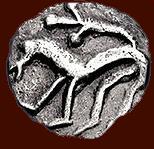








Designed by Nigel G Wilcox






The Paragon Of Metal Detecting
& Archaeology
& Archaeology
Powered By Sispro1
Anglo-Saxon & Viking A.D. - Currency Numismatics,
Thrymsa
For Reference ONLY
Everything For The Detectorist
Copyright All Rights Reserved by Nigel G Wilcox E-Mail: ngwilcox100@gmail.com
Viking Menu
Viking Timeline
Anglo-Saxon Timeline
1 - Early Anglo Saxon - Kent - Post Crondall
GOLD THRYMSA - Two Emperors Type [c.655-755]
obv. Helmeted bust right
rev. Bust of Angel with wings above 2 facing heads1.20g
ref. Spink 767, North 20, Metcalf 79-80
Found - Great Wakering, Essex [TQ9485], 2009
VERY RARE
2. Gold Thrymsa, c620-645, c1.3g, c11mm dia. max. Bust r. with trident./Cross.
GOLD THRYMSA - Two Emperors Type [c.655-755]
obv. Helmeted bust right
rev. Bust of Angel with wings above 2 facing heads1.20g
ref. Spink 767, North 20, Metcalf 79-80
Found - Great Wakering, Essex [TQ9485], 2009
VERY RARE
2. Gold Thrymsa, c620-645, c1.3g, c11mm dia. max. Bust r. with trident./Cross.
| 1. Estimated value: 4750 |

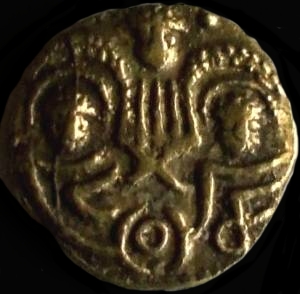
3. The Thymsa…a native Anglo-Saxon gold coin in about the 630s. The Augutalis…medieval gold coin was widespread under the German Emperor Frederick II (*1194, †1250).
Thrymsa's were the first native Anglo Saxon coinage to be produced in England. They are hammered coins, hand made by striking a blank between two dies, the method of coin making which persevered in this country from the first century BC to the 17th century.
With the departure of the Romans in the early fifth century supplies of coins soon dried up, and it is argued that no coins were circulated between the middle of the 5th century and the second half of the 6th century, when small quantities of Merovingian coins (tremisses) began to enter the country. In the late 6th century, coins based on tremisses were first produced in England. These gold thrymsas continued to be minted until around 675, when silver sceattas, essentially debased thrymsas, superseded them.
There are a number of different types of thrymsa, but all are very rare. As noted above, the first were based on the Merovingian tremissis, but others were based on Roman prototypes or were purely Anglo-Saxon in style with runic or meaningless Latin legends. It is thought that there were mints in London and Kent, and possibly York. Wuneetton type thrymsas are thought to be derived from Witmen type thrymsas, and are mainly found, and presumably minted, around London and Kent. Names 'Wunetton' and 'Witmen' come from the coins' Latin legends, perhaps personal names, sometimes blundered and including runes. The Crondall hoard was discovered in 1828 and provides the main source of information on these thrymsas. The hoard is dated to AD 620 - 630's and contained Witmen type but not Wunetton type thrymsas. This and stylistic and metallurgical grounds indicate a date of c 650 for Wunetton type thrymsas. There are only six other recorded Wunetton type thrymsa s and this example is particularly exciting, being the furthest West yet found and of a unique sub-type. Gareth Williams of the British Museum has stated that 'the pellets in the angle of the cross on the reverse represent a sub-type which to the best of my knowledge is otherwise unknown'. It is the only known Thrymsa from Gloucestershire.
4. Saxon England 'Two Emperors Type' Thrymsa
Gold, 1.16 grams, 12.21 mm. Post-Crondall Type; circa 655 to 675 AD. Two Emperors Type inspired by a Roman prototype. Obverse: Bust of the king right, wearing a pearled diadem and cuirass indicated by dots, with XIVI, a pseudo legend to the right within beaded border. Reverse: Bust of a stylized Victory/angel with wings, enfolding two facing heads of two busts. The reverse and general style derived from a Roman prototype. A shortage of gold throughout Europe led to a gradual debasement of Thrymsas from about the middle of the seventh century resulting in the gold Tremisis eventually developing into the silver penny ("Sceat"). The most popular of these later pale gold coins were copied from a late 4th century solidus with Victory between two enthroned emperors. These were probably struck in Kent between 650 and 660 A.D. It is thought that tremisses (commonly called "thrymsas" in England) were in fact shillings of the Anglo-Saxon law and were used more for the payment of compositions and fines rather than ordinary currency. JJ North states: "They are extremely rare and very few specimens are available to collectors." There are twelve coins of this type on the Early Medieval Corpus at the Fitzwilliam Museum [EMC]. Reference: D. M. Metcalf Thrymsas and Sceattas, Volume 1, page 46, for discussion of this series. S. 767; M. 79-80 (different dies); N. 20. Slightly off centre and small flan, otherwise good very fine and an excellent example from an early period in English coinage.
Thrymsa's were the first native Anglo Saxon coinage to be produced in England. They are hammered coins, hand made by striking a blank between two dies, the method of coin making which persevered in this country from the first century BC to the 17th century.
With the departure of the Romans in the early fifth century supplies of coins soon dried up, and it is argued that no coins were circulated between the middle of the 5th century and the second half of the 6th century, when small quantities of Merovingian coins (tremisses) began to enter the country. In the late 6th century, coins based on tremisses were first produced in England. These gold thrymsas continued to be minted until around 675, when silver sceattas, essentially debased thrymsas, superseded them.
There are a number of different types of thrymsa, but all are very rare. As noted above, the first were based on the Merovingian tremissis, but others were based on Roman prototypes or were purely Anglo-Saxon in style with runic or meaningless Latin legends. It is thought that there were mints in London and Kent, and possibly York. Wuneetton type thrymsas are thought to be derived from Witmen type thrymsas, and are mainly found, and presumably minted, around London and Kent. Names 'Wunetton' and 'Witmen' come from the coins' Latin legends, perhaps personal names, sometimes blundered and including runes. The Crondall hoard was discovered in 1828 and provides the main source of information on these thrymsas. The hoard is dated to AD 620 - 630's and contained Witmen type but not Wunetton type thrymsas. This and stylistic and metallurgical grounds indicate a date of c 650 for Wunetton type thrymsas. There are only six other recorded Wunetton type thrymsa s and this example is particularly exciting, being the furthest West yet found and of a unique sub-type. Gareth Williams of the British Museum has stated that 'the pellets in the angle of the cross on the reverse represent a sub-type which to the best of my knowledge is otherwise unknown'. It is the only known Thrymsa from Gloucestershire.
4. Saxon England 'Two Emperors Type' Thrymsa
Gold, 1.16 grams, 12.21 mm. Post-Crondall Type; circa 655 to 675 AD. Two Emperors Type inspired by a Roman prototype. Obverse: Bust of the king right, wearing a pearled diadem and cuirass indicated by dots, with XIVI, a pseudo legend to the right within beaded border. Reverse: Bust of a stylized Victory/angel with wings, enfolding two facing heads of two busts. The reverse and general style derived from a Roman prototype. A shortage of gold throughout Europe led to a gradual debasement of Thrymsas from about the middle of the seventh century resulting in the gold Tremisis eventually developing into the silver penny ("Sceat"). The most popular of these later pale gold coins were copied from a late 4th century solidus with Victory between two enthroned emperors. These were probably struck in Kent between 650 and 660 A.D. It is thought that tremisses (commonly called "thrymsas" in England) were in fact shillings of the Anglo-Saxon law and were used more for the payment of compositions and fines rather than ordinary currency. JJ North states: "They are extremely rare and very few specimens are available to collectors." There are twelve coins of this type on the Early Medieval Corpus at the Fitzwilliam Museum [EMC]. Reference: D. M. Metcalf Thrymsas and Sceattas, Volume 1, page 46, for discussion of this series. S. 767; M. 79-80 (different dies); N. 20. Slightly off centre and small flan, otherwise good very fine and an excellent example from an early period in English coinage.
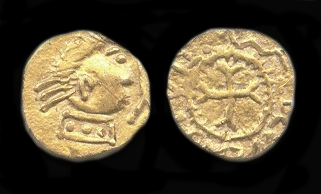
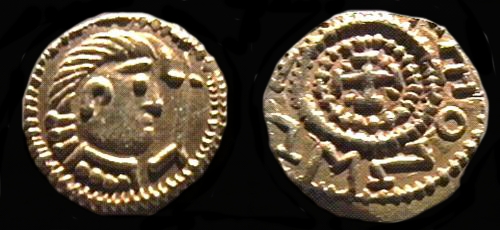
This Thrymsa was found by David Hutton in a field near Newent. It is the only Thrymsa ever known to be found in this part of Britain. It is now on display in Gloucester City Museum.
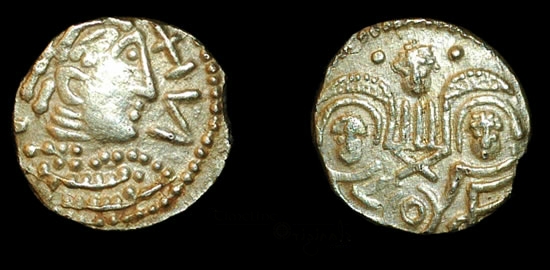
1.
2..
3.
4.
655-755 AD (Varied Kings )
Thrymsa
Pages
Main Coin Menu
Anglo-Saxon
Menu
Menu
Member NCMD
A.S. Menu
Information Data
























